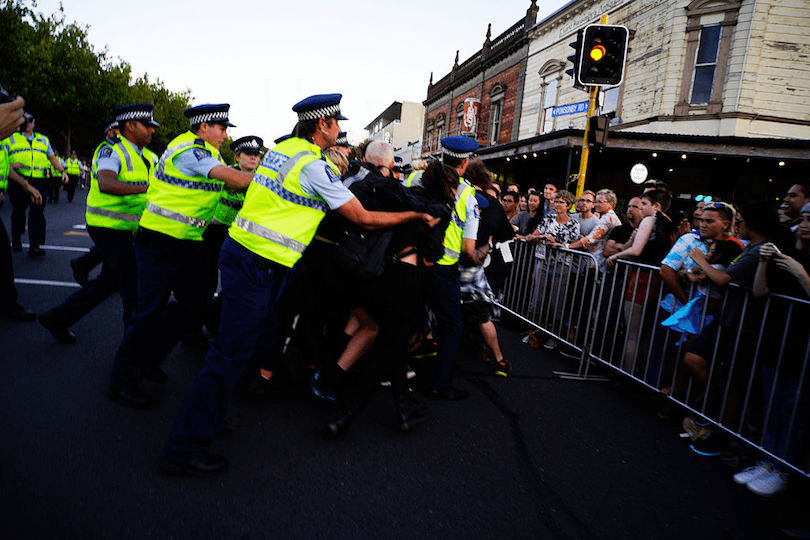Emilie Rākete on the issue that many of the Pride sponsors and participants have overlooked – it’s not just about a history of transphobia and homophobia, it’s also about racism.
In 2015, People Against Prisons Aotearoa (then No Pride in Prisons) disrupted the Auckland Pride Parade to call attention to the brutal, racist, homophobic, and transphobic violence represented by the institutions of the Department of Corrections and the New Zealand Police. Many people cheered as a security guard shattered my arm. As the bone burst open inside my body, about half a litre of blood pulsed out into the space between my muscle and my skin. Over the following months of agonising physical therapy and recovery, the blood rotted inside my arm – pooling in green, red, purple, and grey splotches. This bruise is the rainbow we inherited from the gay liberation struggle.
Last month I visited our sister in prison. Open, weeping cuts wound up and down the length of her arms. Her forehead was split open from banging on the window of the solitary confinement cell in which she spends 23 hours every day. Lots of our sisters write to PAPA for help. They don’t get their hormones. We had to buy a bra for one — after she was raped, management put her in solitary confinement, and she couldn’t afford the cost.
Every week we work with our gay and trans brothers, sisters, and others who are suffering in the criminal justice system. They write to us about the prison guard who calls them a faggot. They write to us about the police officer who slid his hands under their top during a search. We meet them in prison and speak with the wardens. We buy them clothes, help them find apartments when they get out of prison. We run the largest prisoner penpal network in New Zealand. We are doing the work on the front lines with the most vulnerable, the most precarious, the most unsafe people in the gay community.
It is impossible to understand why these people are vulnerable without understanding the institutional racism of the criminal justice system. As this visualiser by Mark Hanna shows, every measurable form of police brutality is disproportionately directed towards Māori. Worse, every year the disproportionality of police brutality towards Māori grows and grows. Even the Police themselves acknowledge their institutional racism. Mike Bush, the Commissioner of the New Zealand Police, acknowledged this systematic “unconscious bias” in 2015. The racism of the Police is a genuine problem which anybody can see, in the black and white of Police statistics and in the words of their own highest officials. The question is whether we care enough to fight it.
What we have with Auckland Pride is an opportunity to ask for meaningful change from the cops. The request for police officers not to wear their uniforms is a symbolic concession and acknowledgement from the Police of what they already pay lip-service to: that for many of us, including the hundreds of our people that PAPA has worked with, the Police are not our friends. This is an opportunity for us to use the platform of Pride to ask the Police for meaningful change. Not platitudes, not promises of diversity, but an actual measurable reduction in violence.
I suggest that Pride set targets for the reduction of racist disproportionality of police brutality statistics. As of 2017, Māori are 7.7x more likely than Pākehā to be victims of police brutality. If the Police are so committed to ending racism, let them reduce the racist disproportionality in their use of force against Māori by 10% next year. If the Police have any real intention to mend the wounds their actions inflict on Māori communities, this should be no problem for them. If the Police are so dedicated to biculturalism, they can start beating, tasering, pepper-spraying, setting attack dogs on, and shooting Māori people only 6.9x more than they do to Pākehā. This is another offer of compromise, the second olive branch held out to the Police by their critics this year.
Last Sunday, at a Pride meeting, one of my elders stood over me and spat in my face for speaking against police brutality. This, too, was a lesson about gay liberation. We are fractured, contradictory, not whole. I am not making this proposal because I hate my elders, or because I have no respect for the work which needs to be done – PAPA is doing this work, and we are all students of gay liberation. This argument is necessary because the revolution our people deserve, the struggle which we have been fighting in our hearts, in our beds, and in the streets, is not yet concluded. Despite the bizarre claims made by some that Māori are an insignificant component of the queer community, the reality is that police brutality against Māori is a queer issue. Not only because takatāpui exist, under police boots as well as in gay bars and clubs, but because we have a duty to solidarity with the oppressed. None of us are free until all of us are free.
All that gay liberation asks of us is our fidelity: who are we to turn away from it?
